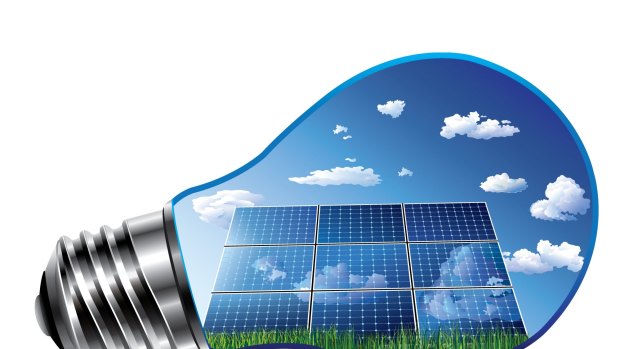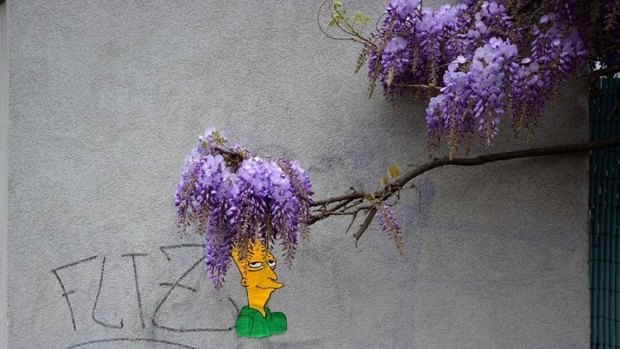This was published 7 years ago
Gang-gang. Slim, ultra-efficient solar panels heralded at science congress
By Ian Warden
The Shine Dome was appropriately bathed in the amber-golden sunlight of this never-ending Indian Summer as, on Wednesday, we bustled up to the Dome to hear the presentation The bright future of solar energy.
The brainy jamboree of Science at the Shine Dome 2016: Human Plus continues inside the Dome. On Wednesday there was a radiant presentation on solar energy given by Associate Professor Kylie Catchpole of the ANU.

Solar energy
Back to the Dome in just a trice but first to explain today's column's sweet little masterpiece of street art.
Surely we have all wondered what Sideshow Bob of The Simpsons would look like if, imitating Dame Edna Everage, he dyed his amazing thatch of red hair a lovely shade of wisteria. We need imagine it no more, for here he is, just added to a wall in Saint-Etienne in France by witty street artist OakOak.

OakOak's street art Sideshow Bob with ephemeral hair.Credit: OakOak
This column continues to promote the world's best (and silliest, and most clever, and most alarming) street art to local artists, to encourage them to go forth and decorate our metropolis. Street art spontaneously inspired by something already in the place, (like a big sprig of wisteria) seems especially delightful. This is OakOak's specialty. Chief Minister Barr, why not make it a Labor election promise to bring OakOak here for a year as street-artist-in-residence?
But off the streets and back into the Dome.
With our dear old planet's dire environmental challenges and exciting opportunities not getting any mentions in the election campaign it was refreshing to be reminded that the world's Kylie Catchpoles are attending to these Big Pictures. As well as being a solar energy evangelist she is at work on how to use metal nanoparticles to make solar panels so much more dainty and efficient than the big flat brutes that suddenly (such is the new appetite for solar power) decorate the roofs of more than a million Australian homes.
"Stabilising the climate is one of the major challenges facing the world today," the youthful professor told us.
"And if we want to meet that challenge we have to completely transform the way in which we use energy ... we have to reduce the use of fossils fuels ... and use the renewable resources available.
We're lucky, she thinks, that we have a wide range of these resources but Australia is especially lucky because solar energy is far and away the best of the renewables and because sunny Australia is especially blessed with a superabundance of sunlight.
"It is a massive resource available to us," she rejoiced as she brought up on the huge screen a huge image of our beloved island continent, decorated in Central Australia with a small red dot and a larger green dot. Imagine, readers, the surface of Australia as the face of Marilyn Monroe, and the red dot was only about the size of the famous beauty spot that decorated the superstar's perfect left cheek.
"So to put this in the Australian context," the scientist continued, "we can see the little red dot here is the area of Australia we'd need to cover [with solar panels] if we wanted to supply all of Australia's needs.
"And here [indicating the green dot about the size, on Marilyn's face, of her perfect chin] is about the area we'd need to cover if we were more ambitious and wanted to supply the whole world."
"So that shows we ought to be thinking of ourselves, of Australia, as a world solar energy superpower. We can certainly supply all our own energy, and export energy to the rest of the world."
But to achieve this, she continued to a rapt audience of scholars mostly old enough to be her aunts and uncles, we are going to have to make solar panels that are cheaper and more efficient. We can make them cheaper if we can make them smaller (using less material) and so she and colleagues are working on making thinner solar cells.
"But of course as we get thinner we have less material to absorb the light. So there's this trade off. So what we've done is we've looked at new ways of actually trapping the light inside a solar cell so that it bounces around. And to do this we've looked at new optical sciences."
But here, among all this talk of 21st century newness, she brought up on the screen some images of the glass Lycurgus Cup, a Roman treasure of the fourth century. It is in the collection of the British Museum. When you look at the cup illuminated by only reflected light, the professor showed us, it is a dull green thing. But when it's held up to the light it becomes colourful and sparkly.
"And the reason for that is that there are tiny particles of gold inside the glass that are scattering the light. So we thought 'OK, if they could do it in the fourth century we can probably do it today'.
"And so 'we're putting tiny metal particles on to the surfaces of solar cells, tiny particles that actually act to make the electrons move back and forward and as a result of that we actually increase the current from the solar cells'."
Buoyed by all this, by the thought that youthful associate professors are thinking of our wrinkly old planet with such affection and aplomb, we gamboled back out into Canberra's generous share of our continent's renewable treasure trove of sunshine.